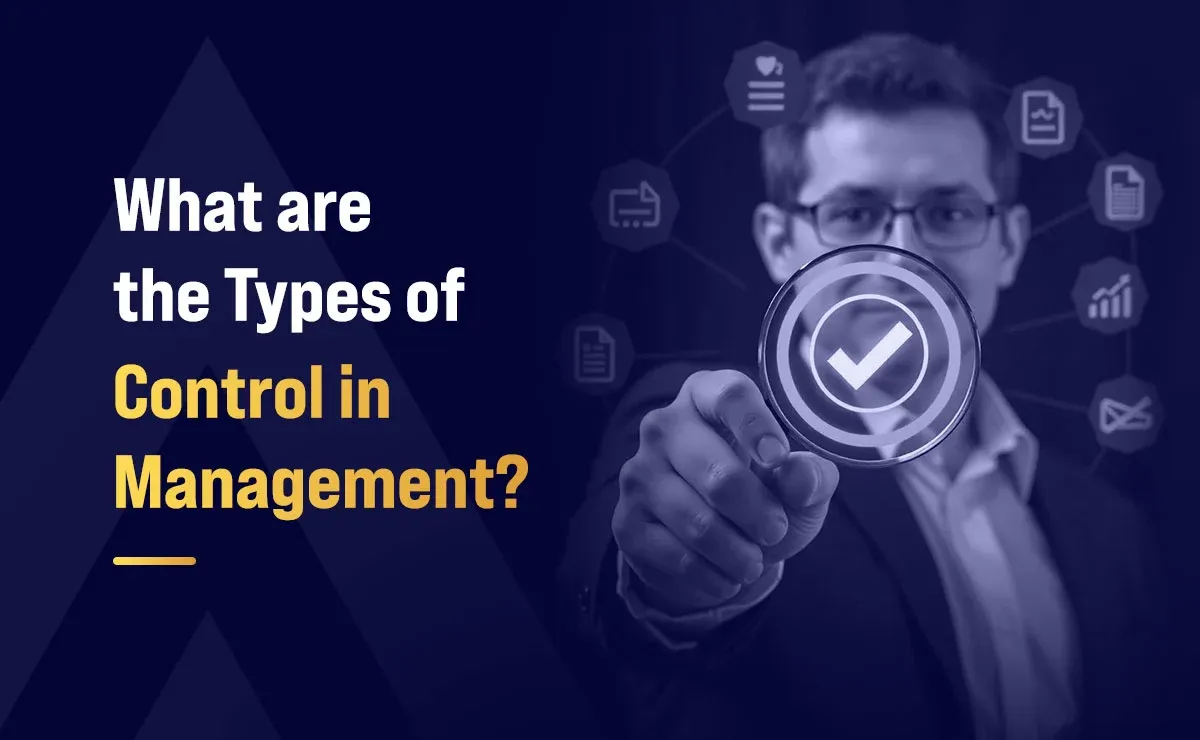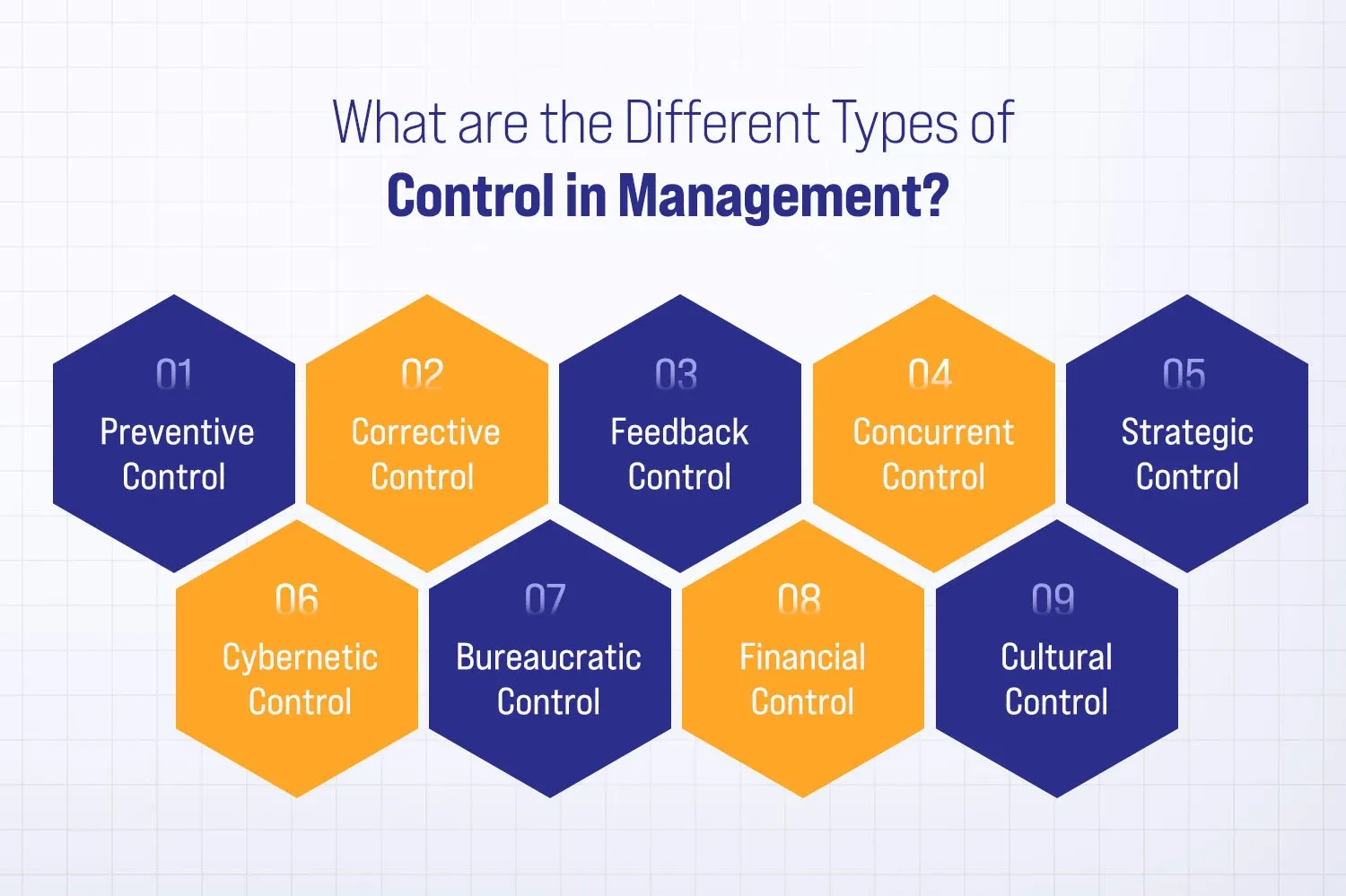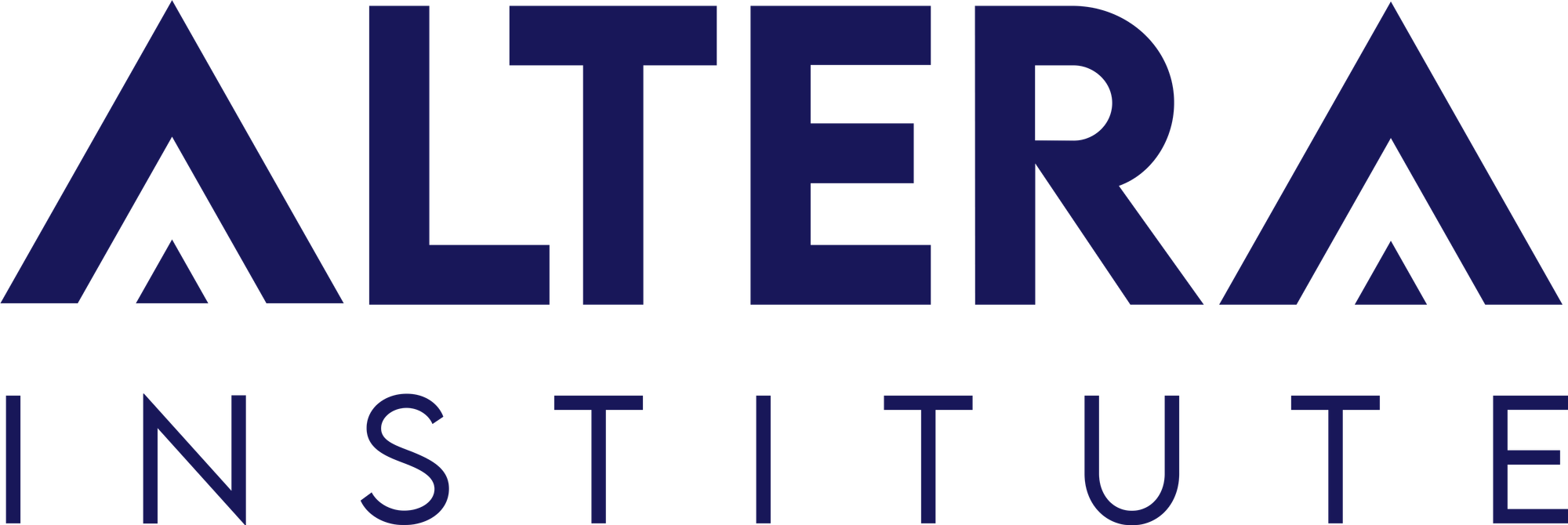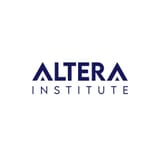What are the Types of Control in Management?

In managerial terminology, control refers to the process of ensuring that an organization's activities are carried out according to its established plans and procedures. It involves monitoring performance measures, evaluating actual outcomes in relation to the set objectives, and taking the necessary action accordingly.
Planning is closely connected with control. Whilst planning determines the direction, control keeps the organization in that direction. Effective control systems enable one to identify discrepancies, analyze the reasons behind them, and take timely measures to mitigate losses and capitalize on opportunities.
Understanding management controls helps leaders make informed decisions and drives organizational success. At Altera Institute, students gain hands-on experience applying these principles, building the skills to manage teams effectively. Start developing your management expertise today.
In this article, we examine what control means in management, the various types of control mechanisms, and how they facilitate efficient business operations.
What is Control in Management?
One of the five fundamental management functions is controlling, with the others being planning, organizing, staffing, and directing. It is the same role that makes sure that the activities of an organization are in line with its already set goals and performance standards. Simply put, control involves the act of monitoring, reviewing, and directing operations to have things on track.
Controlling, at its very core, is about establishing performance standards, measuring actual performance, comparing it to those standards, and taking corrective measures where appropriate. The strategy will ensure objectives are met in the best way possible, and any anomalies are rectified in time.
To be effective, the controlling process must follow several guiding principles:
- Principle of Control Responsibility: Managers should ensure that their teams effectively implement the company's strategic plans.
- Principle of Action: Control must lead to constructive action; it is only meaningful when deviations result in improvements.
- Principle of Control Individuality: Each level of management should have tailored controls suited to its responsibilities and scope of authority.
- Principle of Standardization: Uniform and objective performance standards are essential for consistent measurement across departments.
- Principle of Goal Orientation: All control efforts should directly support the achievement of the organization's long-term objectives.
Controlling acts as a compass that keeps teams aligned with the company’s vision, enabling timely intervention when things veer off course.

What are the Various Kinds of Control in Management?

There are various control mechanisms applied in organizations, and these mechanisms are intended to address specific phases and aspects of operations. Management works in conjunction with these types of control systems, which are used to monitor performance, quality, and support strategic direction.
1) Preventive Control
Preventive control is a proactive measure that involves foreseeing possible issues and avoiding them before they arise. It aims to address the sources of deviation by taking steps such as articulating policies, educating staff, and implementing quality assurance mechanisms. This type of control reduces errors because tasks are executed accurately during the initial stages of development.
Key Tools & Techniques:
- Policies and Procedures: Detailed Standard Operating Procedures (SOPs) provide guidance for employees to achieve consistent performance.
- Training & Onboarding Programs: Ensures employees have the skills to avoid mistakes.
- Safety Checks and Quality Gates: In manufacturing, products are tested at critical points to prevent defects from progressing further.
2) Corrective Control
The corrective control exists on a reactive principle. It is used when anomalies of the expected outcomes are observed. Its main focus is to identify the root causes of issues and implement remedies to prevent their recurrence. This can take the form of problem-solving, performance reviews, and process enhancements.
Key Tools & Techniques:
- Root Cause Analysis (RCA): This is a systematic process of identifying the root causes of performance failures.
- Performance Appraisals: Systematic evaluations of employee performance that are used to indicate areas in which improvement is required.
- Process Redesign: Re-engineering of ineffective or inaccurate processes to improve workflow.
3) Feedback Control
Feedback control is dependent on gathering and evaluating performance information after a task is accomplished. It enables the managers to evaluate the achievement of the goals and provide information to improve further endeavors. The support of this control method is often based on tools such as KPIs and performance reports.
Key Tools & Techniques:
- Key Performance Indicators (KPIs): Numerical measures applied to determine the performance of an organization in key areas such as sales, productivity, or customer satisfaction.
- Variance Reports: Reports comparing the actual performance with the budgeted performance and therefore indicate any significant deviations.
- Customer Feedback and Surveys: Direct input from clients that helps assess service or product quality.
4) Concurrent Control
Referred to as real-time or steering control, concurrent control tracks activities as they unfold. It enables managers to make immediate adjustments if things start to deviate from the plan. Examples include live production tracking or real-time quality checks in manufacturing.
Key Tools & Techniques:
- Dashboards and Live Monitoring Tools: Real-time visual displays of key metrics for processes like production, logistics, or sales.
- Supervisory Oversight: Active operations management to guide, support, and correct employee actions as needed.
- Control Charts: Statistical tools used in manufacturing to track process variation in real time.
5) Strategic Control
Strategic control ensures that the organization stays aligned with its long-term vision and mission. It involves a regular review of strategies and objectives to make sure the company is progressing in the right direction. It is critical for adapting to market shifts and organizational changes.
Key Tools & Techniques:
- Balanced Scorecard: A strategic planning tool that evaluates performance from multiple perspectives, including financial, customer, internal processes, and learning/growth.
- Benchmarking: Measuring an organization’s tactics against top competitors to adopt industry-leading methods.
- SWOT Analysis: The analysis compares internal strengths and weaknesses with external opportunities and threats.
6) Cybernetic Control
The concept of cybernetic control involves automated processes and feedback to manage complex systems with minimal human intervention. In industries that involve robotics or automated systems, constant monitoring and real-time adjustments ensure efficiency and accuracy.
Key Tools & Techniques:
- Sensors and Actuators: These devices help monitor the state of a process and make adjustments.
- Programmable Logic Controllers (PLCs): Industrial automation devices that execute machine functions using preset algorithms.
- SCADA Systems (Supervisory Control and Data Acquisition): Sophisticated platforms for overseeing and managing complex industrial operations.
7) Bureaucratic Control
Such control is founded on formal rules, procedures, and hierarchical structure. It is focused on standardization, compliance, and accountability. Although bureaucratic control brings about consistency and order, it may occasionally impede innovativeness due to excessive rigidity.
Key Tools & Techniques:
- Standard Operating Procedures (SOPs): Written directions that facilitate uniformity in tasks.
- Formal Hierarchies: Well-defined reporting relationships and structures of authority.
- Compliance Checklists: These are the checklists used to check compliance with internal policies or legal regulations.
8) Financial Control
Financial control is aimed at controlling the economic resources of an organization. It involves budgeting, financial analysis, auditing, and cost control. It is a form of control that ensures the financial sustainability of an organization by monitoring income, expenditure, and investment policies.
Key Tools & Techniques:
- Budgeting: Allocating resources to different departments or for project management based on forecasts and priorities.
- Financial Statements (P&L, Balance Sheet, Cash Flow): These statements help track revenue, expenses, assets, and liabilities.
- Investment Analysis: Assessment of a possible investment based on such instruments as ROI (Return on Investment), NPV (Net Present Value), and IRR (Internal Rate of Return).
9) Cultural Control
The reason behind cultural control is based on what is expected, or, in the case of an organization, the shared values and traditions that guide its operations. It does not work through rules, but rather through corporate culture, which shapes the behavior of its employees. Cultural control that is robust will create intrinsic motivation and organizational goal congruence.
Key Tools & Techniques:
- Organizational Culture Development: Initiatives that shape culture through mission statements, storytelling, rituals, and symbols.
- Leadership Modeling: Leaders exemplify the values and behavior they expect from others.
- Onboarding and Socialization: Processes that help new employees adapt to the company culture.
Features of Controlling
Controlling is a vital managerial function that ensures activities are aligned with organizational goals. The following are the defining traits of management control.
1) Future-Oriented by Nature
One of the most significant aspects of controlling is that it looks ahead. Although it relies on historical data and past performance to evaluate current progress, the ultimate purpose is to shape future actions. Managers use control systems not just to detect errors but to anticipate and prevent them in future operations. This proactive mindset makes control an essential tool for forward planning and strategic adjustment.
2) Applicable at Every Level of Management
Top-tier executives are not the only ones who can exercise control. It is a universal role that cuts across all levels of managerial ranks- top management down to frontline supervisors. When top management deals with strategic control, such as the adherence to policies and organizational direction, middle and lower levels also apply operational control to make sure that daily work and department-level requirements are achieved effectively and efficiently. Therefore, control becomes a ubiquitous activity, fitting itself to various positions in the hierarchy.
3) Ongoing and Uninterrupted Process
The process of control is not an action carried out at a single moment in time, but rather it is a continuous and cyclical process. Performance is regularly measured by managers, compared with set benchmarks, and the processes are adjusted accordingly. This continuity ensures that any deviations are rectified as soon as possible, and the processes are also guided towards the desired goals. Good control does not end; it changes according to the altering conditions and results of performance.
4) Constructive and Purpose-Driven
The controlling function is not designed merely to identify faults or impose restrictions—it plays a constructive role in enhancing both organizational and individual performance. It helps organizations stay on course toward their strategic goals while also promoting personal accountability and productivity among employees. This way, control encourages a culture of development, discipline, and improvement, and this is very beneficial to all the stakeholders.
Process of Controlling
The management control process is an organized and methodical approach that facilitates maintaining alignment among organizational activities to achieve the set goals. It entails a set of rational choices that guide managers in tracking performance, detecting problems, and making the necessary adjustments to stay on pace. Below is a breakdown of all the stages of the controlling process:

- Setting Performance Standards: The first step in the controlling cycle is to establish clear and measurable performance benchmarks. These benchmarks serve as guidelines to judge the effectiveness of executed tasks. To be effective, standards should be aligned with the organization’s overall objectives, be realistic in scope, and include specific timeframes.
- Measuring Actual Performance: Once standards are in place, the next task is to assess how operations are performing in reality. This involves collecting accurate data on employee output, departmental results, or system efficiency through various tools and techniques.
- Comparing Results with Set Standards: In this step, the actual performance data gathered is evaluated against the established benchmarks. The purpose is to identify gaps or discrepancies that indicate whether activities are on course or deviating from expected outcomes.
- Investigating Deviations: When performance does not match the standards, it's crucial to analyze the cause of such deviations. Understanding whether the gap is due to internal inefficiencies, external factors, or unrealistic standards helps managers decide on the appropriate response.
- Taking Corrective Measures: The final step in the controlling process is to take action to correct problems or improve systems. This can be achieved through changes in work processes, reassigning resources, or providing employee training to address performance differences. It may also be necessary in certain situations to reconsider and revise the initial standards if they are found to be unworkable.
This gradual approach allows the organizations to not only track the performance efficiently but also to constantly optimize their work, ensuring their success in the long term and attaining their goals.
FAQs
Q1. What are the areas of control in management?
Ans: Areas of control in management are considered the main functions and operations of an organization that are monitored by managers to bring efficiency and meet the organizational objectives. The most frequently used areas of control are:
- Financial Control
- Operational Control
- Quality Control
- Human Resource Control
- Marketing Control
- Strategic Control
The areas enable managers to maintain control over vital organizational processes and implement corrective measures as needed.
Q2. What are the types of control in strategic management?
Ans: In strategic management, control ensures that long-term goals and initiatives stay aligned with the organization’s vision. Key types include:
- Strategic Control: Assesses whether strategies are effective and adjusts them in response to internal or external changes.
- Premise Control: Evaluates whether the assumptions underlying strategic plans are still valid over time.
- Implementation Control: Monitors whether strategic plans are being properly executed and whether milestones are being met.
- Special Alert Control: Resolves emergencies or unexpected events that require existing emergency strategic changes.
Summing Up
Controlling is not only a management role, but it is the driving force that keeps an organization on track towards its objectives. Control enables managers to be responsive to the challenges they face and ensure operational efficiency by constantly monitoring performance, identifying deviations, and taking corrective steps in a timely manner.
In strategic management, financial discipline, culture-based alignment, or timely adaptations, a robust control mechanism fosters accountability, uniformity, and improvement throughout the organization at all levels. In a modern, dynamic business world, the art of controlling has become key to long-term success, sustainable growth, and competitive edge.





